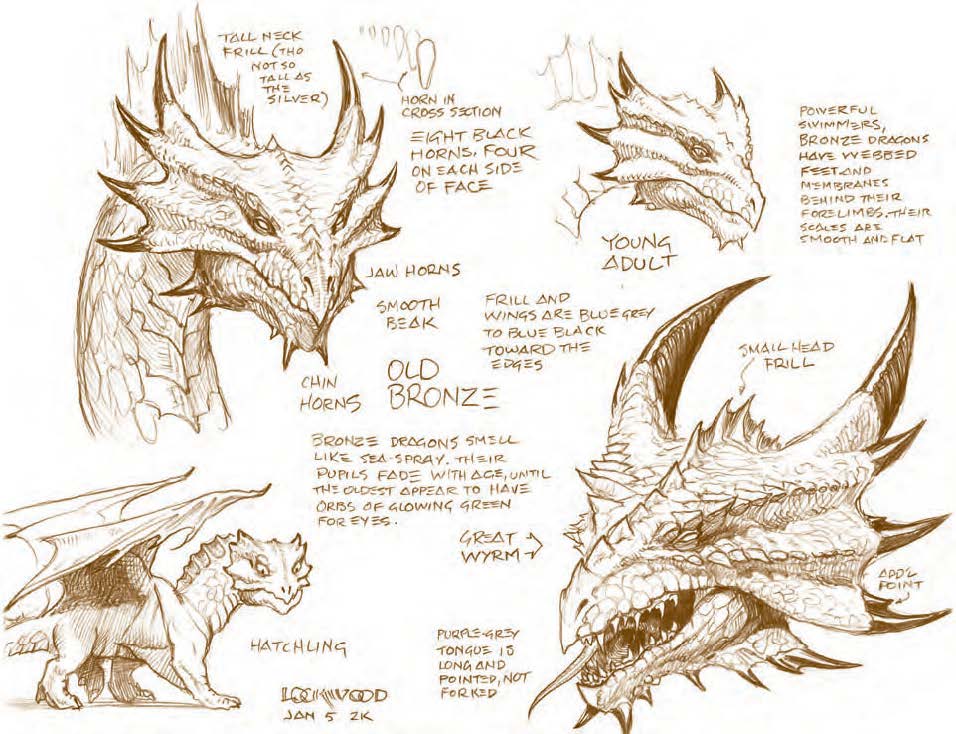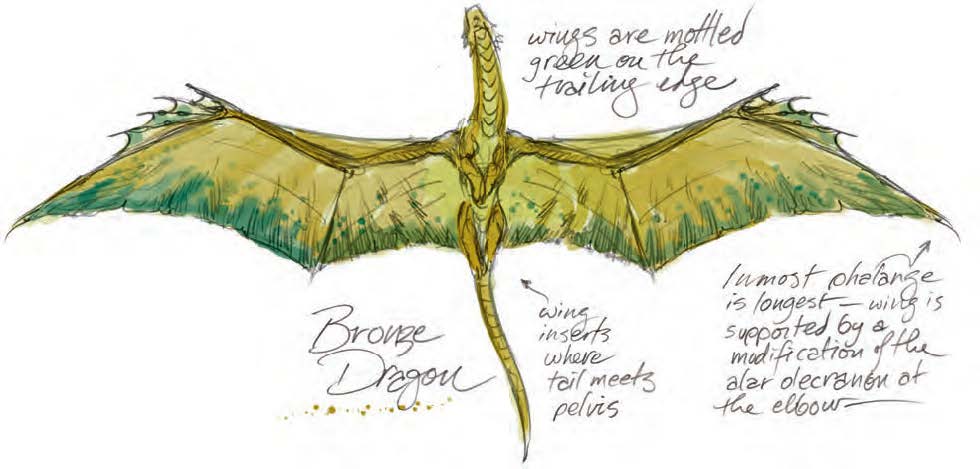Bronze Dragon
Bronze dragons have a strong sense of justice and do not tolerate cruelty or anarchy in any form. Many a pirate or robber has faced swift retribution from a bronze dragon using an innocuous disguise. Bronze dragons also have an inquisitive side and find the activities of other creatures, particularly humanoids, endlessly fascinating. They enjoy polymorphing into small, friendly animals to study such activities. Bronze dragons like to be near deep fresh water or salt
water, and are found in temperate and tropical coastal areas and islands. They often visit the depths to cool off or hunt for pearls and sunken treasure.
Bronze dragons wage a constant struggle against evil sea creatures, particularly ones that menace the coasts, such as sahuagin, merrow, and scrags. They sometime find themselves with black or green dragons for neighbors. While the bronzes are content to live and let live, the evil dragons are seldom willing to return the favor.
Bronze dragons prefer make their lairs in caves that are accessible only from the water, but their lairs are always dry— they do not lay eggs, sleep, or store treasure underwater. Often, a bronze dragon’s lair has a lower area that floods at high tide and an upper area that remains dry around the clock.
Dungeon-dwelling bronze dragons often live near underground streams or lakes.
Bronze Dragon Identifiers
A bronze dragon in its true form can be recognized by the ribbed and fluted crests sweeping back from its cheeks and eyes. The ribs in the crests end in curving horns. These horns are smooth, dark, and oval in cross-section, and curve slightly inward toward the dragon’s spine. The largest horns grow from the top of the head. In older dragons, the smaller horns often develop secondary points. The dragon also has small horns on its lower jaw and chin. A bronze dragon has a beaklike snout and a pointed tongue. It has a small head frill and a tall neck frill. A bronze dragon has webbed feet and webbing behind the forelimbs. Its scales are smooth and flat. A bronze wyrmling’s scales are yellow tinged with green, showing only a hint of bronze. As the dragon approaches adulthood, its color deepens slowly to a darker, rich bronze tone. Very old dragons develop a blue-black tint to the edges of their scales. Their pupils fade as they age, until in the oldest the eyes resemble glowing green orbs. A smell of sea spray lingers about them. When viewed from below, a bronze dragon’s wings show green mottling on the back edges. The trailing edge of the wing membrane joins the body behind the rear legs, at the point where the tail meets the pelvis. Most of the alar phalanges are very short and form a wide frill just beyond the alar thumb. The innermost phalange is the longest, and it provides most of the support for the wings, along with a modified alar olecranon at the “elbow” of the alar limb (see page 8). This arrangement allows the dragon to use its wings as big fins underwater. A bronze dragon can flap its wings when submerged and literally fly through the water.Habits
A bronze dragon spends much of its time in an assumed form, usually that of a small animal or an older humanoid. This charade serves the dragon’s inquisitive nature by allowing it a chance to observe the world without drawing attention to itself or disrupting the flow of events. Bronze dragons value moral order and altruism. Bronze dragons frequently congregate with others of their kind, making them among the most gregarious of the true dragons. When in their natural form, they sometimes swim or play together in the waves. They gather even more frequently when using assumed forms, particularly when observing some event of interest to them. They find warfare fascinating, and many have served in armies fighting for good causes. Afterward, they may spend decades debating the course of the war, its causes, and its consequences. Though they have no lack of draconic pride, bronze dragons enjoy the company of humans and other humanoids. They consider these “lesser” creatures to be just as deserving of survival and happiness as themselves. When in the company of humanoids, a bronze dragon usually assumes humanoid form, both as a practical matter (it can be very hard to fit a bronze adult into a seaside cottage), and to keep the humanoids at ease. Bronze dragons delight in testing a stranger’s sense of decency by posing as penniless beachcombers, shipwrecked sailors, or guileless primitives. Unscrupulous creatures who attempt to cheat, bully, rob, or kill a masquerading dragon soon find more trouble than they had bargained for when the dragon reveals itself. Creatures who conduct themselves well may never know they have actually encountered a bronze dragon. Nevertheless, good conduct earns the dragon’s respect, and it is usually remembered, perhaps to be rewarded someday. Most bronze dragons maintain a constant watch for pirates, natural disasters, and ships in distress. Many a shipwrecked mariner has been rescued by the timely intervention of a bronze dragon. Because bronze dragons usually perform such rescues while disguised as something else, the beings they save often remain unaware of exactly who their benefactor was. Courtship and mating among bronze dragons is always a deliberate and respectful affair. Bronze dragons mate for life, and one often refuses to take a new mate after the death of the original mate. They always tend their eggs and offspring carefully and defend them to the death if necessary. Bronze dragons eat aquatic plants and some varieties of seafood. They especially prize shark meat, and often spend days at sea hunting sharks. They also dine on the occasional pearl. They often keep pearls in their lairs, both as treasures and snacks. They admire other treasures from the sea as well, such as bits of rare coral and amber. Though they don’t care to admit it, their favorite metal is gold, which does not tarnish in their humid lairs. Bronze dragons usually attack only in self-defense or to defend those unable to defend themselves. They dislike killing anything they don’t plan to eat, and they try especially hard to avoid killing animals that are merely defending themselves. They usually try to distract attacking animals with food, using their repulsion breath to fend them off if distractions fail. Against intelligent foes, bronze dragons usually try to negotiate, but remain wary of duplicity. Often, a bronze dragon figures out a way to be victorious in a conflict without dealing damage, such as stranding a foe on an island or dismasting a ship at sea.Sources:
- Dungeons & Dragons Draconomicon (3.5 Edition, 2009).
- Monster Manual, Bronze Dragon
Related Ethnicities




Comments